Managing a team can be complex, especially when juggling everything from payroll to performance reviews. That’s where Zoho People Plus comes in. It’s an all-in-one HR management platform designed to make your life easier by bringing together all the tools you need to manage your workforce efficiently. Whether you’re running a small business or a large company, Zoho People Plus helps you keep everything organized and running smoothly.

Zoho People Plus is a comprehensive HR management system that combines everything you need in one place. It’s part of the broader Zoho suite, known for its user-friendly design and powerful features. You can handle everything from hiring and onboarding to payroll and employee engagement, all from a single platform.
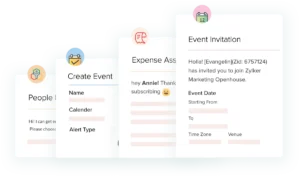
Keeping track of employee details is a breeze. You can store all your employee information in one organized database, making it easy to find what you need, when you need it. Plus, you can customize the fields to fit your company’s specific needs.
Say goodbye to manual time tracking. It offers automated time tracking and attendance management, integrating with biometric devices and mobile apps to ensure accuracy. Whether your team is in the office or working remotely, you’ll always have a clear picture of who’s working when.

Payroll can be a headache, but Zoho People Plus makes it simple. The platform automates salary calculations, tax deductions, and other payroll tasks, helping you avoid errors and stay compliant with local regulations. And with direct deposit support, payday is easier for everyone.
Hiring the right people is crucial, and this platform makes it easier than ever. Manage job postings, track applicants, and evaluate candidates all within the platform. Once you’ve made a hire, it streamlines the onboarding process, helping new employees get up to speed quickly.
Keeping track of employee performance is key to helping your team grow. Zoho People Plus offers tools for setting goals, giving feedback, and conducting performance reviews. With a clear performance management system, you can ensure that everyone is aligned and working toward the same objectives.
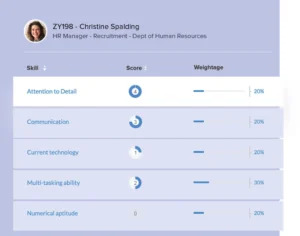
Zoho People Plus includes a self-service portal where employees can handle their own HR tasks, like updating personal info, requesting time off, and viewing payslips. This not only saves time for your HR team but also gives employees more control over their own work life.
Continuous learning is essential for keeping your team engaged and up-to-date. Zoho People Plus includes a learning management system (LMS) that allows you to create and manage training programs, track progress, and assess outcomes, ensuring your team is always learning and growing.
A happy, engaged team is a productive team. Zoho People Plus offers tools to run surveys, manage recognition programs, and foster better communication and collaboration within your team. These features help create a positive work environment where employees feel valued and motivated.
Zoho People Plus stands out because it’s flexible, scalable, and easy to use. It’s designed to adapt to your company’s unique needs, whether you’re managing a small team or a large, distributed workforce. And since it’s part of the Zoho suite, it integrates seamlessly with other Zoho apps, making it a powerful tool for building a cohesive business ecosystem.
Plus, because it’s cloud-based, Zoho People Plus keeps your HR data secure and accessible from anywhere. The mobile app also lets managers and employees handle HR tasks on the go, providing the flexibility that modern businesses need.

Zoho People Plus is more than just an HR tool—it’s a complete solution for managing every aspect of your employee lifecycle. By automating routine tasks, improving engagement, and providing valuable insights, Zoho People Plus allows you to focus on what really matters: helping your team succeed.
Whether you’re looking to streamline your HR processes, boost employee satisfaction, or support your team’s growth, Zoho People Plus has you covered.
See other ways Zoho can boost your HR Department:
Efficient data management is a necessity and a competitive advantage; with businesses accumulating vast amounts of information, the ability to organize, analyze, and derive insights from data visualization tools is a must.
Zoho, a leader in business software solutions, recognizes this need and has introduced Zoho Tables, a powerful tool designed to streamline data management processes. In this blog post, we'll delve into the features and benefits of Zoho Tables and explore how it can revolutionize how businesses handle their data.

Zoho Tables is a cloud-based online database management software that offers a comprehensive suite of tools for managing, analyzing, and visualizing data. It is part of the Zoho Office Suite, which includes a range of productivity applications tailored for businesses of all sizes. With Zoho Tables, users can effortlessly organize their data, collaborate with team members, and gain valuable insights to drive informed decision-making.
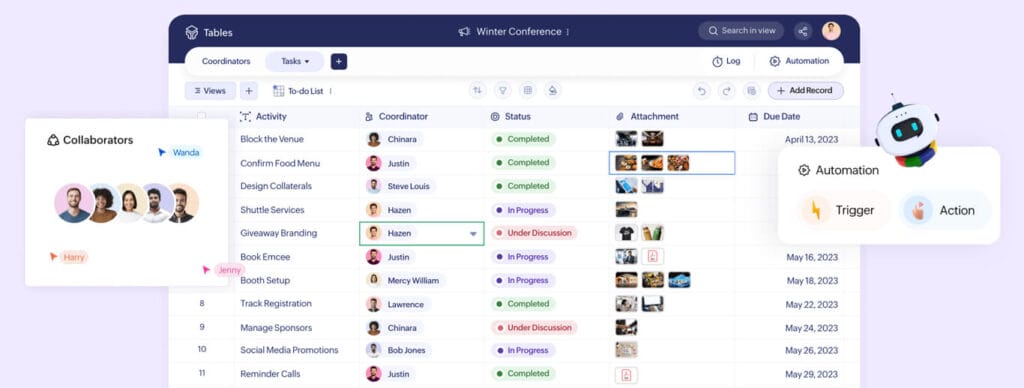
Zoho Tables is a robust application that goes beyond the basic capability of its competitors. Here are just a few of the key features. The full list is available here.
Zoho Tables boasts a user-friendly interface that makes it easy for users to navigate and utilize its features without extensive training or technical expertise. The intuitive drag-and-drop interface allows users to effortlessly create tables, import data, and customize views to suit their needs.
Visualizing data is crucial for understanding trends, patterns, and relationships within datasets. Zoho Tables offers a variety of visualization options, including charts, graphs, and pivot tables, enabling users to explore their data visually and gain deeper insights.
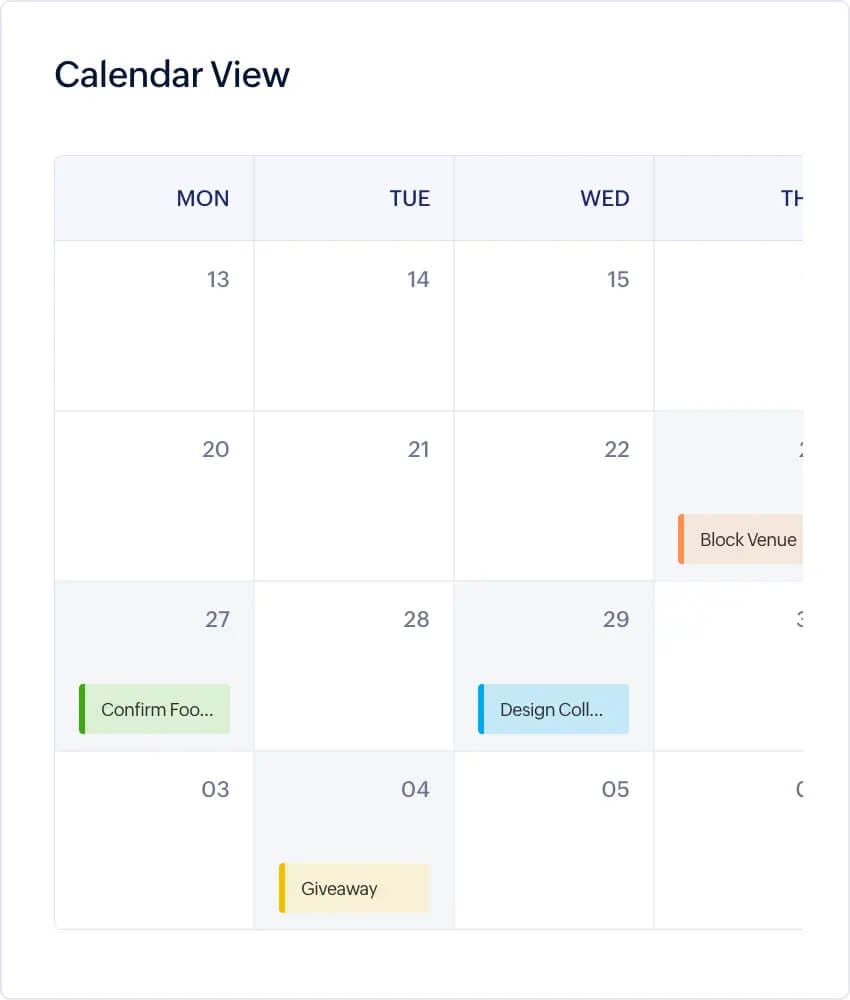
Collaboration is essential for modern businesses, especially when it comes to managing data. Zoho Tables facilitates seamless collaboration with team members through features such as real-time editing, comments, and sharing permissions. Users can work together on projects, provide feedback, and stay updated on the latest changes to the data.

Zoho Tables includes automation features that help streamline repetitive tasks and workflows. Users can set up automated workflows, triggers, and actions to perform tasks such as data updates, notifications, and data validations, saving time and reducing the risk of errors.
As part of the Zoho ecosystem, Zoho Tables seamlessly integrates with other Zoho applications such as Zoho CRM, Zoho Analytics, and Zoho Creator, allowing users to leverage the full power of the suite. Additionally, Zoho Tables supports integration with third-party apps and services through APIs, enabling users to connect their data with external systems and tools.
Collaboration, a UX interface, and increased productivity are major benefits of Zoho Tables. Let’s take a closer look.
Zoho Tables helps businesses boost productivity and efficiency by centralizing data management and automating repetitive tasks. Users can spend less time on manual data entry and manipulation and more on analysis and decision-making.

With its collaborative features, Zoho Tables promotes teamwork and communication among team members. Whether working on a project together or sharing insights, users can collaborate in real time, leading to better outcomes and faster decision-making.
Zoho Tables empowers users to uncover valuable insights from their data through advanced analytics and visualization tools. By visualizing data trends and patterns, businesses can make data-driven decisions and identify opportunities for growth and optimization.
Whether you're a small startup or a large enterprise, Zoho Tables scales to meet your needs. Its flexible architecture allows users to easily adapt to changing requirements and scale up or down as needed, ensuring that the platform remains relevant and effective as businesses grow.
Zoho Tables offers a cost-effective solution for data management, with flexible pricing plans designed to accommodate businesses of all sizes and budgets. With no upfront costs and pay-as-you-go pricing, businesses can enjoy the benefits of Zoho Tables without breaking the bank.
In conclusion, Zoho Tables is a game-changer for businesses seeking to streamline their data management processes and unlock the full potential of their data. With its intuitive interface, powerful features, and seamless integration with the Zoho ecosystem, Zoho Tables empowers users to organize, analyze, and derive insights from their data like never before.
Whether you're a small business looking to get started with data management or a large enterprise needing advanced analytics capabilities, Zoho Tables has you covered.
Embrace the power of data with Zoho Tables and take your business to new heights. Our team of experts will help you set up seamless integrations. Learn more here.
Is tech enabling your business or getting in the way? There are so many SaaS and CRM platforms to choose from. On top of that, there are email and SMS marketing, social media, HR, and payroll platforms. All of these business tools are necessary to generate leads, see a healthy ROI, and build a business for sustainability. What is in your tech stack—the sum of all the platforms your business uses in daily operations? The most important aspect of any Tech Stack is ensuring your chosen platforms communicate with each other.
ICE-ing, a fancy little acronym will help your team leverage your tech platforms for premium efficiency.

When we talk about ICE-ing your tech stack, we’re focusing on Integration, Customization, and Expandability.
We’ve provided a “premium efficiency” handy checklist for you below.
Let’s break that down (ICE, ICE Baby….no?).
Here are the main questions to answer when it comes to your tech stack and integration.

The issue with the lack of integration isn’t a straightforward simple answer. In fact, the absence of a solid integration plan is costing your business money, your team time, and potential efficiency.
Ensure your company is running smoothly with ultimate integration and sustainable efficiency with a platform that can do multiple jobs. For example, view your tech as a new hire in the company. You likely wouldn’t hire one HR Director to conduct interviews and another to conduct paperwork for new hires. The same person would cover both responsibilities. Spreading your tech stack thin without integration in mind is like hiring for multiple positions when you don’t need to.
Zoho is a SaaS company that covers a lot of ground! Zoho Flow allows you to tie your apps together with a nice, efficient bow. The platform is phenomenal! Integrate your other daily operations apps like Slack, Gmail, Asana, Creator, and, of course, other Zoho applications!
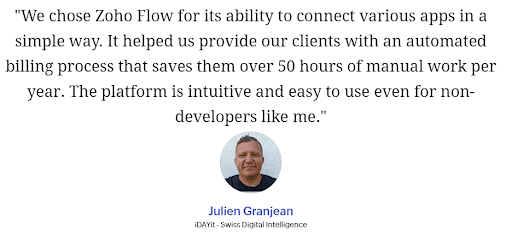
So, what should you keep in mind when it comes to customization? We’ve got the info!:
Every business is different, meaning your business and team need customizable options within SaaS platforms. Each department needs a customizable workflow, communication, etc. Unfortunately, many software companies are a “one size fits all” and charge extra for each customization. It’s vital to search for the most cost-effective and efficient option for your team’s needs.
Create workflows, reminders, and store vital client information in a way that works best for your team. Zoho CRM makes teamwork easy with its customization and interface. Its state-of-the-art customization options make running a small team of five to a large team of 100+ easier. One of the best aspects of Zoho CRM is the pricing—no hidden fees or costs for customizing the platform to be the way you need it.
Every business operates to grow and expand. Is your current tech stack up for the job?

Dropping the ball with leads is easy to do when your tech stack isn’t ICE’d. To expand your business, your team needs to be on top of their game when it comes to leads and building rapport with potential customers.
Zoho CRM is the perfect example of a user-friendly and customizable platform. Build strong customer relationships and team morale with Zoho CRM. It does the heavy lifting while your team focuses on what matters most—customers. Create triggered workflows where you never forget to follow up on what’s most important—a customer’s questions or concerns. Zoho CRM makes it easy to scale your business on (near) autopilot.
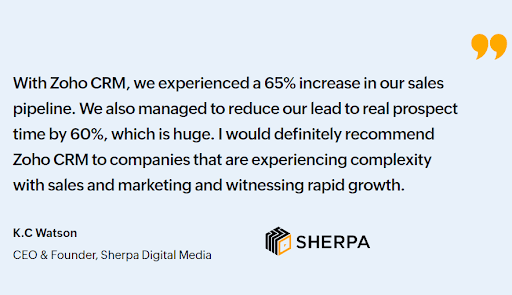
As official Zoho partners, our Zoho support team is next-level. We can help you with any hiccups, if any, your team encounters. We also provide Zoho integration services to keep your business up and running while we work behind the scenes.
Book your free consultation today!
What’s better than an epic SaaS company? A SaaS Company that prioritizes its employees and pays it forward with future generations in mind.
If you’ve been around here for a hot minute, you know our team at Woggle is ‘Team Zoho’ all the way. We can’t say enough about the platform’s incredible versatility and perks. We’re also Zoho Partners–we’re equipped to help business owners like you transition from your existing platform to Zoho. Our favorite SaaS company also does a fantastic job of looking into the future and building grassroots opportunities for talent.
Today, we’re bragging about Zoho’s humanitarian and environmental efforts; giving you even more reason to choose their platform for your business needs.

When you think of a software company, you probably don’t think of employees working from a fully functioning farm. Zoho purchased 360 acres to build its new headquarters in Austin, Texas. Shortly after purchasing the land, Zoho had a change of heart. Rather than build another modern highrise headquarters, they decided to create a farm. The timing was serendipitous. Shortly after the decision to start the farm, the COVID-19 pandemic hit the United States.
The rural project has been an incredible success—giving Zoho employees solace in the outdoors, access to the fresh fruit and vegetables they have grown, and a refreshing respite from skyscrapers and city noise.

One benefit of the farm is Zoho employees are bonding through their experimental farming projects. It’s an opportunity to tap into creativity and real-time problem-solving. Mickey Stanley, Zoho’s head of PR content, says, "The metaphor of the farm is to break down the silos, right? So we couldn't just compartmentalize all the different produce. What we want is this kind of loose learning process where everything isn't overly manicured and everything is kind of growing into each other. And we see what works."
Stanley shares another perk of Zoho’s unconventional farming workplace—the interpersonal interactions between the team members, “You go into an office and it's the same people in your section of the office that you see and talk to. But here, somebody could walk in and sit down next to you and be doing their work and you have the ability to make a new relationship with a coworker that you wouldn't otherwise."
We don’t know about you, but walking out to pick fresh fruit on a lunch break sounds amazing. That has been amazing for morale! Zoho’s farm isn’t its only innovative idea. As a matter of fact, Zoho is paying it forward in numerous incredible ways!

Zoho has taken its streak of genius and run with it, creating rural offices at other Zoho locations; including India, Mexico, Japan, and Canada. Zoho’s vision with these rural offices is to make opportunities accessible to talented individuals who may not otherwise be candidates for jobs in tech due to their location. Zoho decided to infiltrate the areas where the talent lies—setting up shop in rural villages and employing locals.
Zoho’s humanitarian efforts bring opportunities to people in small towns and villages. The additional benefit is that the current workforce issues of inflation, long commutes, and general life/work imbalances are alleviated.
The beauty of Zoho is its focus on creating a better world for its users and employees. Their initiatives don’t stop at the farm outside of Austin, Texas, or creating opportunities in rural villages around the world. The SaaS company also provides subscription relief to businesses impacted by natural disasters. Their eco-friendly reach is also impressive—they build solar farms that offset our carbon footprint.

Zoho is impressive in its own right when it comes to its technology and incredible offers for businesses like Woggle Consulting. Add the humanitarian and eco-conscious efforts and it’s a company that’s worth supporting.
Book a free consultation to chat about Zoho. Our friendly team is happy to help answer your questions!
Get to know Zoho’s incredible assets by reading more of our blog posts:
There’s something that all businesses have in common—the need for organization.
We heard that deep sigh from here.
Sure, not all of us have a knack for organization or even an interest in it, but we’ve found an app that helps even the most unmotivated of us to put things in order.
Whether you’re leading a team or are a solopreneur, it’s vital to keep all of your ducks in a row. Today, we’re bringing you a Woggle team favorite—(of course, it’s Zoho). We’re not saying you have to “Marie Kondo” your business, but we do think she’d be a huge fan of Zoho Flow because of its awesome efficiency. Let’s jump in for a quick tour of Zoho Flow and how you can utilize it in your business regardless of size, niche, or current workflow.

Let’s paint a picture.
Imagine having your work and personal tasks and delegation platforms siloed into one glorious app. Instead of getting distracted by constant notifications across various applications, you have a birdseye view of your workflow, pending tasks, and where the rest of your team is on projects. Incoming requests, client inquiries, and time-sensitive tasks are all housed in one, user-friendly data-view.
That’s Zoho Flow.
It looks something like this.
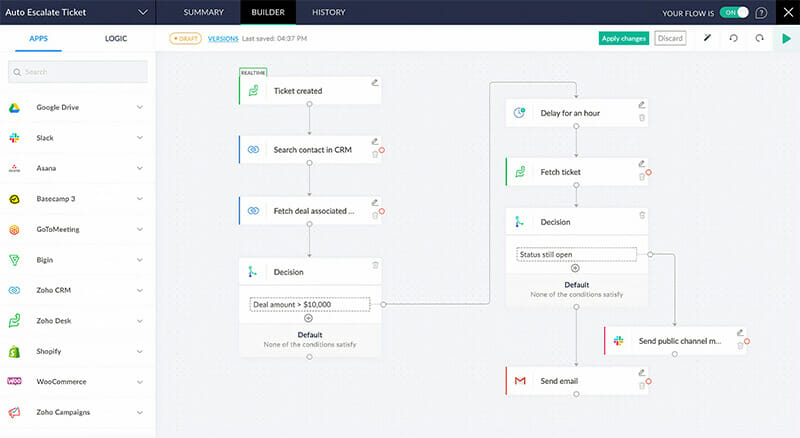
On the left, you have your integrated apps that are essential to the smooth flow of your daily operations. The workflow is seen at a glance on the right. Now, let’s dig deeper.
Let’s answer your burning question before we jump into the details of building a workflow inside Zoho Flow. We know you’re wondering, ‘Yeah, great, but does Zoho Flow work with the existing apps that I need for my business?’
We’re going to go out on a limb here and say, “Most likely!”
Zoho Flow is compatible with 800+ apps!
Here are just a few of the applications Zoho Flow seamlessly integrates with:
If you’re already onboard with Zoho, you’re ahead of the game because Zoho Flow will easily work with the Zoho apps you’re already using!

Click here for a full list of applications you can use with Zoho Flow.
Bonus Info: Read our blog to learn more about the awesome RingCentral app. Already using Zoho? Learn how to Improve Your Skills Inside Zoho’s The Workflow Academy.
If you’re like us, you have a lot of irons in the fire at any given time. Running a business doesn’t look the same for any two businesses out there, but we can guess you’re managing team communication, marketing efforts, and making sure clients are taken care of—all at the same time. Zoho Flow condenses your ‘to do’ list into one space and gives your team so much flexibility in setting up workflow.
Here are the main attractions:
Get your team on the same page at any given time with personalized workflows. Actions can be triggered along the way for each team member to take the lead in the client/project journey. No more manual delegation!
Zoho Flow easily communicates between your everyday work apps. Need your CRM to trigger an invoice for a client while also pinging your Marketing Director for a follow-up? No problem! Zoho Flow keeps everything from leads to daily communications in sync.
Have an overview of your workflows and any hiccups along the way. Seeing everything from a bird’s eye view allows you to fix issues as they arise. No more deep digging for the problem. Also, keep an eye on what’s working for your team and where the workflow can be improved.
Read more about Zoho Flow’s epic features here.
Here’s how custom workflows can work for your team. Imagine it—a workflow that keeps all of your essential apps in one place!
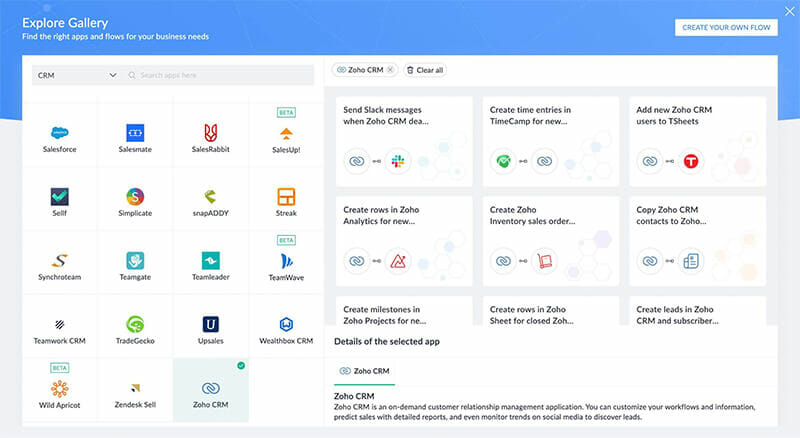
Zoho Flow is basically the fairy godmother of your business operations. It turns a hot mess express into a tangibly smooth-flowing business. Use our direct link to get started. As official Zoho Partners, our team can help you get set up and keep things running smoothly.
Not sure where to start with Zoho? Reach out to our team for a consultation!
What does your current marketing strategy say about your business? Whether you’re new to the game and the ink just dried on your LLC papers or you’ve been around long enough to reinvent your business several times, marketing is crucial to your success. Let’s clarify—strategic marketing is essential for the success and longevity of your business. Marketing trends come and go, and sometimes they even come back to leave again. If you pay attention to marketing tips for any length of time, you’ll see they ebb and flow like the tide which can leave business owners like us feeling overwhelmed, right?
Thankfully, our business partners and rad friends over at Lucent Creative, an all-female digital marketing agency, help us to stay focused and on-point with our marketing efforts. Today, we’re sharing some nuggets of wisdom their team shared with us. Before we jump in, let’s review a few stats about marketing.
These marketing stats are just scraping the surface of why strategic marketing is essential to the life of your business. Marketing gives you a platform to share your product or service, but strategic marketing gives you a direct line with your ideal customer. See the difference?

Let’s get straight to the tips from our friends at Lucent Creative. Take these five action steps straight to your team today.
Do you feel that your marketing strategy is complex, but not accomplishing much? If you’re following marketing trends rather than your ideal customer, it’s time to reassess. For example, if your ideal customers are retirees looking for wealth management options, your TikTok strategy probably isn’t yielding great results.
Lucent Creative’s CEO and Founder Kendall Walker shared,
“I have been in marketing for years and have seen a lot of ambitious and well-intentioned businesses stall in their growth because they weren’t focused on their marketing efforts. Thankfully, there are always opportunities to stop, reassess, and pivot. My advice to businesses with any marketing budget is to study where their ideal customers are and put their marketing efforts exclusively into those platforms.”

Read all about creating an email campaign that rocks with Zoho Campaigns.
Customers purchase from brands they trust. Earning the trust of your ideal client or customer requires engagement. Ironically, this is a step that is either neglected entirely or not focused on enough in marketing strategies. We got some insight into engagement with Lucent Creative’s social media strategist.
“I encourage clients to engage with their followers daily. If someone comments on your post, it’s crucial to reply. It’s a marketing 'hack' that humanizes your brand and helps build trust. Engagement doesn’t take a lot of time. If you spend ten minutes a day engaging with your followers in the comments and stories, I bet you’ll see an influx in sales soon. You’ve given them a reason to go all-in with just a few minutes of approachability.”
You may know what to say about your product, but do you know how to reach your ideal audience? This is where brand voice (what you say) and brand tone (how you say it) come into play. A business selling life insurance plans wouldn’t have the same brand voice or tone as a hot sauce company. Technically, anything could happen, but we’d venture to say it just wouldn’t be strategic or best practice.
Lucent Creative’s copywriter gave us a few tips in this area.
“Establishing your brand voice and tone is the foundation of your marketing strategy. It all starts with being incredibly intentional about who you’re talking to and how they can benefit from your product. Explore your ideal customer’s needs, struggles, purchasing habits, and anticipated hesitations about buying your product. If you do this, you’re going to set your entire marketing team up for success.”

Marketing isn’t a “set it and forget it” aspect of business. It’s as important as your product development, sales, and employee retention. What is working today may need adjusting next quarter.
Kendall Walker shared another piece of wisdom with us about the need for pivoting often.
“Marketing strategies need to grow and change with your business. Algorithms change, of course, but so do your customers and their expectations. What works now may not work next year. Keep an eye on the data, customer feedback, and ultimately, the trajectory of your business. Think of your marketing strategy needing frequent “checkups”. Schedule these and get your team thinking creatively about how to make your great strategy even better.”

How’s your website working for you? Read Your Guide to Designing an Epic Website
Be mindful to recognize and thank your loyal customers. Your business can do this in a lot of ways, but starting with a simple loyalty program or exclusive offers is a great place to invest your time and money. 75% of consumers will favor a brand if there is a loyalty program. 71% of consumers who are members of loyalty programs say membership is a meaningful part of their relationships with brands.
To wrap up, we asked Kendall, her social strategist, and copywriter to share their insight on how businesses can best show appreciation for loyal customers. Here’s what they had to say.
“I can’t stress the importance of creating the image of being a thorough and approachable brand. People want to know they can ask questions, express concerns, and rely on you, the expert, to give them valuable insight.”
Kendall, Lucent Creative CEO and Founder
“I agree with Kendall. The way to create a multiple-level point of contact people actually want to take advantage of is through intentional copywriting. Show your brand personality and always put the customer first in all of your written content. People catch on immediately if they’re appreciated and if they can keep trusting your business/product.”
Lucent’s copywriter
“To go along with this theme, I think it’s important to remind businesses that their social media is their “storefront” and their “first date”. This is the first impression of your brand. This goes beyond social media, of course. Your website matters. Email marketing campaigns are also a first-row view into your brand. Be consistent and your customers will continue to trust you and purchase from you.”
Lucent’s social media strategist
We all know marketing is important, but these five tips are ways to go the extra mile for your customers. The main idea is to not become complacent in your marketing efforts. Keep an eye on the data and your customers’ needs.
If you’re looking to partner with Woggle and Lucent Creative for your marketing efforts, get in touch to book your free consultation call.
Your website acts as the first impression for customers and clients. In part one, we gave you the rundown on web design statistics and a few pointers on creating an epic design. If you missed that post, check it out here.
You may not be designing your site from the ground up, but we encourage you to audit your existing site against today’s tips. What checks out and how can you make improvements? A well-designed website doesn’t mean it has to be a robust or high-tech site. Really, a lot of intentionality and attention to detail will result in a website that puts the user’s needs front and center.
Let’s get straight to today’s tips!

There are multiple reasons to give site visitors value straight out of the gate.
Here are just a few:
So, how do you provide value on your website? We discussed social proof in last week’s post and how it elevates your brand’s expertise. There are multiple ways to pique visitors’ interest and get them to stick around.

Three ways to provide value to your customers:
Integrate a chatbot into your web design. Customers need a place to get answers to their questions. Enter chatbots. They provide the customer service element while also adding value to your brand. Customize your chatbot to fit your brand to create a memorable customer experience.
Have a free resource library. Provide immense value while also capturing emails and building your email list. A free resource library should be more than just one pdf download. We recommend using multiple kinds of media since we’re all unique and retain information differently. Webinars, downloads, audio recordings, and interactive worksheets are all great fits for a resource library. Build a robust library that rivals your competitors and you’ll generate loyal customers!
Our web design partners at Lucent Creative built an epic landing page for a boutique African travel agency. Check out the value that’s offered to customers right away.

Web Design and copywriting rely on each other to create a memorable site for your potential customers/clients. Work with a designer that sees the value of emphasizing your brand’s message. A web designer and copywriter essentially have the same goal–to put your brand on the map and create an uncomplicated journey for your customer to commit to a purchase.
Here are a few tips to keep in mind for optimizing your message through design:
Your design and brand messaging should go hand-in-hand. Our biggest piece of advice would be to have a look at some websites you like and then, pull inspiration for your project. Here’s a round-up of our favorite projects by Lucent Creative. Pay attention to how the design supports the message:
A dog training and pet care services company:
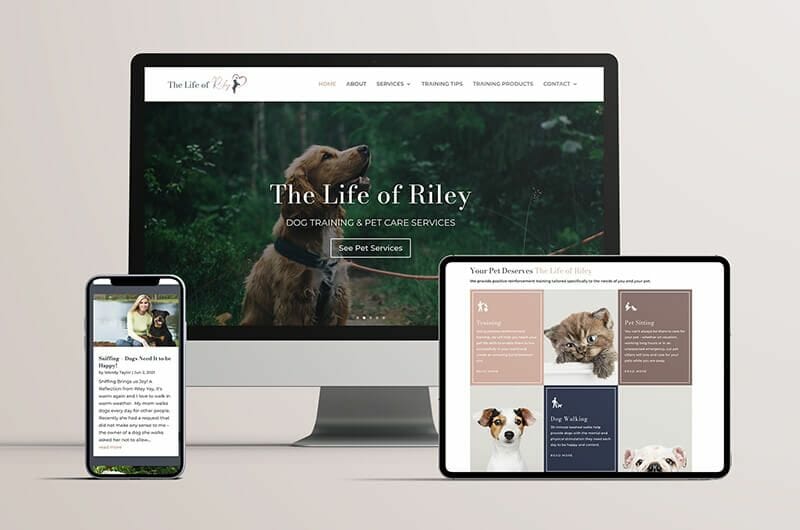
A pizza franchise brand:
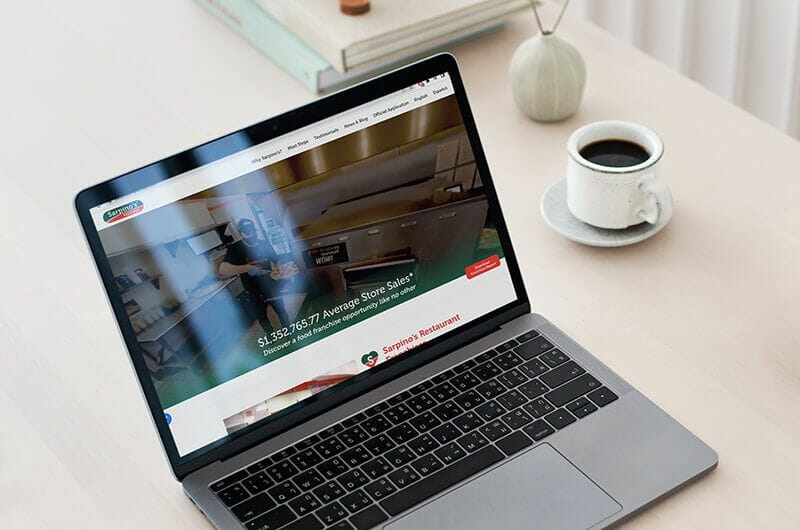
An online event:

Search Engine Optimization is a specialty as it should be! It’s a multi-faceted beast and we’re going to go ahead and suggest you hire an SEO expert.
Did you know over 53% of overall website traffic comes from organic search?
The difference between a DIY approach and hiring an SEO guru is that your website will see the light of day! Optimizing your site with SEO means:

As with any strategic marketing move, you’ll want to work with someone who also understands the data. What are your analytics teaching you about your current setup? Where are there areas for improvement?
Our partners at Lucent Creative have an SEO team and we’ve worked closely with them to optimize our site.
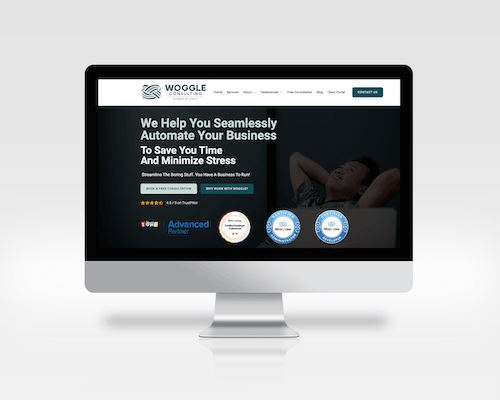
We’ve already established your business needs a great website to compete in the online space. It’s not only a great first impression for potential clients, but can also act as an ongoing resource for existing clients.
Whether you need a website refresh or need one from scratch, we’re in the business of helping!
Learn more about our partners at Lucent Creative here.
Contact our team to book a free consultation call.
Don’t forget to catch part one of this series.
You may sit blankly staring out a window most days pondering, ‘If only there was a way to streamline my business operations and experience joy again.’ The reality is, your business doesn’t have to merely survive day-to-day. You can put systems in place that allow you to run your company more efficiently and finally feel like the boss you are (both literally and in the 80s lingo).

Enter Zoho, the one-stop shop for business automation goodness.
As official Zoho Partners, we are obviously huge fans of the platform and we see how its integrations improve business operations big and small.
We’ll also show no shame in admitting that Zoho is (beautifully) complex. It’s a platform that takes time to learn and ultimately, conquer.
Enter The Workflow Academy–where Zoho One begins to make a little more sense to the everyday user!
Afterall, every time a bell rings, a Zoho user becomes a Zoho Master (or something like that).
In a nutshell, The Workflow Academy is the superior spot for Zoho training. Whether you’re the team’s Zoho Admin or are all-in hanging out in the deep end of the platform, The Workflow Academy has a course with your name on it.
Have you been on the fence about getting Zoho for your business?
Here’s your sign to go for it!
Oh, and a helpful statistic to drive the benefits home–92% of employees say having technology that helps them do their job efficiently affects their work satisfaction, according to a study by Ultimate Software.
Now that you know you can have an amazing platform to help run your business and learn how to master, what is there to lose?
Go ahead and make your free Zoho One account here.
We’ll wait for you!
[cheesy elevator music]
Congrats! You’re officially in the game with Zoho One now.

Let’s continue to walk through the perks of TWA and get you enrolled in their free course.
At Woggle, we see clients that don’t realize the areas they’re losing valuable leads, revenue, or customer satisfaction until they start using Zoho and see the data roll in.
Spoiler alert: sometimes it’s areas they least expect or think they’re excelling in.
Not only does your business thrive when problem areas are identified and remedied; employees are able to focus on what they do best with a little help from their friend (automation).
So, what does The Workflow Academy help Zoho users perfect?
Here’s what we love about the courses over at The Workflow Academy:
✅Their online courses are free to Zoho users (yes, please!).
✅Learning is made easy to access across all devices.
✅There are so many courses to choose from! (Zoho One, Zoho Books, Zoho Projects, oh my!)
✅Empowering your staff to understand Zoho on a deeper advanced level
✅Get a better understanding of how Zoho works on the backend
✅Learn how to properly architect a solution that will work for your company
✅Diagnose needs and find a partner that will work well with you to create a customized solution
Pro Tip: Read our blog post on why hiring a Zoho consultant is the right move (objectively, of course).

As we mentioned, The Workflow Academy allows your business to pinpoint issues in your workflow that may be damaging customer satisfaction results. All businesses aren’t created equally and learning how to use Zoho will guide you to championing the unique nuances of each aspect of your business.
For example, your ideal client or customer may not need an extensive onboarding process, but setting it on autopilot can still save your company time (and time is money).
Still eager to learn more about how Zoho is an all-inclusive super machine for automation?
Read more about how Zoho SalesIQ’s Customer-First Approach Can Boost Your Business here.
We’ve mentioned (obsessively) how Zoho integrations can skyrocket revenue, customer satisfaction, and daily operations. The real beauty of Zoho is the compatibility it has with both B2B and B2C models.
The Workflow Academy equips your Zoho agency to know every small nuance of the platform as well as how to troubleshoot and personalize it for your unique business needs.
This means you become an expert on all things Zoho including:
The list goes on!
Zoho can feel like a complex beast, but really, it can be tamed! Investing in your knowledge of how your chosen CRM platform works is the best thing you can do for your business!
Read more about Zoho’s magical features like Zoho Surveys and Zoho Social in our other blog post.

The main gist?
Your business can run as efficiently as you’re willing to invest in automation.
The Workflow Academy takes you from out of the loop to expert. Don’t be the person who invests in a phenomenal tool, but doesn’t learn how to use it.
Eager to learn more about The Workflow Academy? Check them out here!
Jump in head-first by opening a free Zoho account.
We have officially entered the era of data-backed decisions and online solutions! Yes, gone are the days of endless file cabinets and office trinkets most millennials wouldn’t be able to identify (we’ll let you use your imagination on that one).
It’s 2022– you probably wouldn’t be where you are without a solid website or some kind of SaAS running behind your operations. What tactics and strategies have you added to your business that has helped with sustainable growth and continued success?
If your answer doesn’t include a CRM, but you have seriously contemplated utilizing a CRM, you’re in the right place! We definitely encourage business owners to give CRMs a try, and we imagine managing your customer relationships (along with just about everything else), all from one place is pretty tempting!
The right CRM solution is going to be different for every business. So, for the indecisive entrepreneurs or the biz owners that just can’t commit, we have done a quick comparison between 2 top CRMs: Zoho and Hubspot!

One main similarity between Zoho and Hubspot? Both CRMs are popular and help people effectively run their businesses every day! Now for some more technical similarities:
User-friendly- When considering customer feedback, both seem to be very user-friendly. New to the CRM world? No problem! Both are known to have interfaces that are decently simplified and easy to figure out. According to our research, Hubspot seems to be slightly easier to use overall, but Zoho has tons of accessible resources if you can’t figure something out.
Preferred by certain industries- If you ask other professionals within your business niche, they may very well have the CRM that’s worked best for them. Keep in mind that business owners have probably not tried multiple CRMs to give a fully fair comparison! With that said, Zoho CRM is a pretty clear front runner in the real estate industry, while Hubspot seems to be favored by the insurance industry. With a quick Google search, you may find some useful insight about the best CRM for your industry!
Plenty of options- Both Hubspot and Zoho have multiple plan options, giving you the ability to choose what best suits your business. They also both offer free trials so you can see if it’s even worth your time in the first place!

One thing we often talk about on our blog is customization. We love a good customization situation! The one-size-fits-all mentality is just not for us; we’d rather be able to pick a good fit versus overpaying for features we’ll never use or items we can’t tailor to our needs.
With that said, Zoho CRM seems to be immensely better on the customization front. Sure, you can customize things on Hubspot, but Zoho allows you to customize buttons, user experiences, record designs, and even sales stages. An added benefit? Sandbox- a testing environment that allows you to test out changes without immediately causing all kinds of disruption (hey, you may change your mind).
And remember when we mentioned data-backed decisions? This kind of data gets to you and your team through reports, and Zoho allows you to access customized reports no matter the plan! With Hubspot you can only do this with the Professional and Enterprise plans.
Zoho has an entire product devoted to social media: Zoho Social. This product comes integrated with Zoho CRM and easily connects all social accounts, including your Google profile. Unfortunately, Hubspot lacks most social media analysis and integrations.
Both Zoho and Hubspot come with a whirlwind of third-party integration options. However, you have to seriously consider what applications and software you already use (or plan to use) before making a CRM choice. This is because each CRM has a lengthy list of integrations, but that list might not include what you need. For instance, Hubspot does not integrate with Google Analytics or PayPal (and that could be problematic).

Fact: Automating processes saves you time and money. Therefore, you’d expect your CRM to be decently helpful in this area, right? Good news: both Zoho and Hubspot allow you to automate many things, from lead scoring to de-duplicating contact data. However, a lot of these features are only accessible with Hubspot’s top plans, whereas you can access with Zoho for far less money.
Zoho also uses AI to do all sorts of things, including identifying patterns, analyzing data, and making workflow suggestions. Although Hubspot gives the ability to automate items like email alerts and triggers, it lacks AI and its tremendous contribution to automating tasks.
If you take a look at pricing for Zoho vs Hubspot, you’ll initially be shocked at the difference, However, you have to take into consideration that Zoho CRM is priced per user and Hubspot is not.
Zoho’s free CRM plan allows up to 3 users, while Hubspot is seemingly unlimited. But even with unlimited users, you will be much more limited on Hubspot's free and starter plans. Zoho gives access to a lot more features at a much lower price point, making it great for smaller businesses on a limited budget.
Zoho’s pricing plan also allows better scalability, given that growing businesses could quickly be priced out of Hubspot. Not to mention, a lack of automation options can make smooth scalability even more difficult.
It’s no mystery that both CRMs are solid options. Whether you go with Zoho or Hubspot, just make sure it suits your business needs and gets the most out of your hard-earned money!
And as always, let us know what you think of your experience with either CRM– we’re always curious!
Want to find out how we can help you?
Let’s chat.
The ‘customer is always right’ ideology has been a staple in businesses for quite some time. And in case you are wondering: yes, this even includes the more…difficult customers (we figured we’d have to clear that up sooner than later).
When it comes to the success of any business (no matter the size), listening to customer opinions and feedback will never lose importance. That’s where the rising emphasis on the Voice of the Customer (VoC) comes in– businesses have to constantly consider customer feedback and figure out how it should/can be incorporated in future actions and changes.
While not exactly a brand new concept, there are new and fresh ways to tackle the VoC challenge, especially within CRMs like Zoho. Let’s dive a little more into this concept of VoC and why it’s important to your business!

When we use the phrase Voice of the Customer (VoC), we don’t just mean customer feedback! VoC refers to methods of collecting feedback, analyzing this feedback, and figuring out ways to improve your business with what you decipher.
In reality, will our businesses truly succeed without considering customer opinions? The answer is a definite no; no matter how hard you try, you cannot properly operate without taking feedback into strong consideration.
And let’s face it, you are there to serve your customer base, right? The success of your business heavily depends on customer satisfaction! There’s no sustainable way to ignore feedback.
Placing a bigger emphasis on the VoC will:
Now that you are convinced to more seriously consider the VoC, let’s take a look at some tactics!
What is the best way to approach the VoC? There’s no surefire method that will work for every business! You have to figure out the right message and how to effectively communicate with your customer base, so not all methods are necessarily equal.
A great place to start (and one we often recommend) is Zoho’s CRM. CRM = Customer Relationship Management– you can’t go wrong with something that has the words customer and relationship right in the title!
No matter your situation, it’s best to first take a look at all the products Zoho CRM has to offer and decide what would best suit your business. Then, you can choose your own set of applications and create a model that will best cater to the voice of your customer.
Zoho Social- Social media is a scary challenge to tackle– so many platforms and so many things you might miss! Does social media tend to leave you overwhelmed? (It definitely overwhelms us about 98% of the time!)
With Zoho Social, you can manage DMs (direct messages) from all your platforms all in one place. Zoho will even gather contact details from these conversations and create a work ticket if necessary.
Zoho Social keeps track of Google reviews and questions, social mentions, and wherever your biz is the hot topic of conversation! Pretty appealing to have an app track this kind of thing rather than scroll and search for hours on end!
Zoho Surveys- You know where we are going with this! What better way to understand the VoC than asking customers directly? Zoho Surveys allows you to create customized surveys, even offering over 250 templates to make the process that much easier for you.
Want to ask some questions on Facebook? Okay! Want to send an email survey? Zoho has you covered! Reach customers in whatever way you need to and get the valuable feedback you seek!

Zoho Desk- If you let it, this product can contribute a large piece to that customer service puzzle! Just because you have a small business, you shouldn’t be limited to low-tech options. Zoho Desk helps you simplify customer service operations and build a lasting relationship with your customers!
Zoho Desk utilizes AI to tag tickets and send them to the correct employee. It can also identify customer sentiment and set aside issues that caused a negative reaction for further research down the road. Track agent activity, automate follow-ups, and integrate with applications you already use.
Zoho Desk will analyze data and patterns to well-equip you for future decisions. Plus, even though it’s high-tech, your customer will still have a super personalized experience!
Zoho Sales- Sure, the name seems simple– but we all know the strategies behind ‘sales’ are much more complex! A key part of sales is catering to your audience and cultivating a relationship with your customers. With Zoho Sales, you can analyze content performance, where site visitors spend their time, and figure out the best way to start conversations with prospective customers. Sync data with Zoho CRM and create a fine-tuned message for your audience!

The Voice of the Customer may seem like an overwhelming and complicated adventure, but it doesn’t have to be. You already consider the voice of your own customers on a daily business whether you realize it or not!
The key takeaway here is figuring out how to use the data behind the VoC and tailor your operations for ultimate customer satisfaction! There’s always room for improvement, and Zoho’s CRM is ready to help, and so are we!